Business Law Case Study: Contract Formation and Postal Rule Analysis
VerifiedAdded on 2021/05/30
|7
|1759
|265
Case Study
AI Summary
This case study analyzes a business law scenario involving a horse sale between Penny and Ron. The core issue revolves around whether a valid contract was formed and, if so, when. The analysis delves into the elements of contract formation, including offer, acceptance, and consideration. The facts involve Penny's initial offer to purchase a horse, Ron's counter-offer, and Penny's subsequent acceptance via mail. The case applies legal principles from various precedents, such as Pharmaceutical Society of Great Britain v Boots Cash Chemists and Adams v Lindsell, to determine the validity of the acceptance and the timing of contract formation, ultimately concluding that a contract was formed on February 10th due to the application of the postal rule. The analysis also considers the intentions of the parties and the presence of consideration.
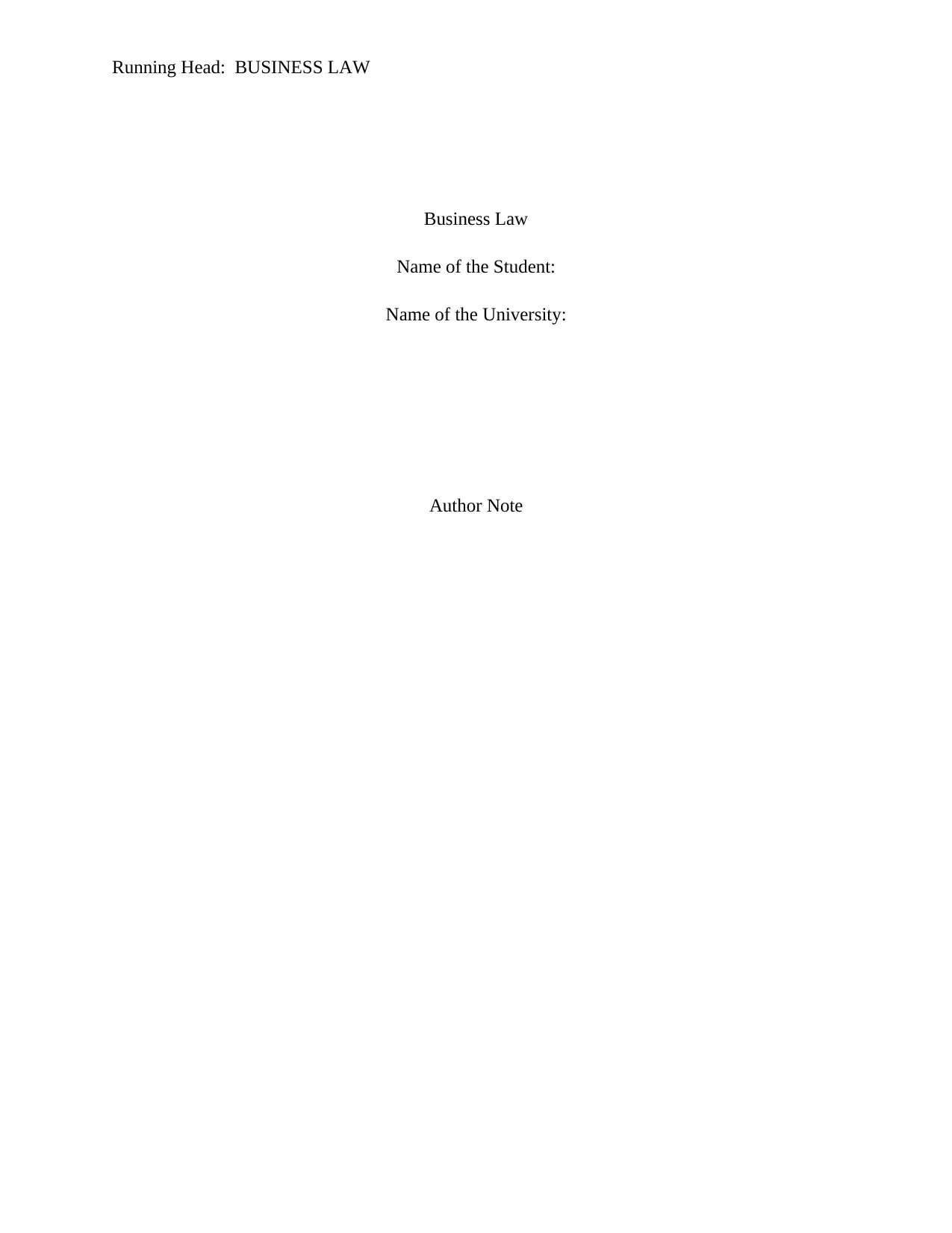
Running Head: BUSINESS LAW
Business Law
Name of the Student:
Name of the University:
Author Note
Business Law
Name of the Student:
Name of the University:
Author Note
Secure Best Marks with AI Grader
Need help grading? Try our AI Grader for instant feedback on your assignments.
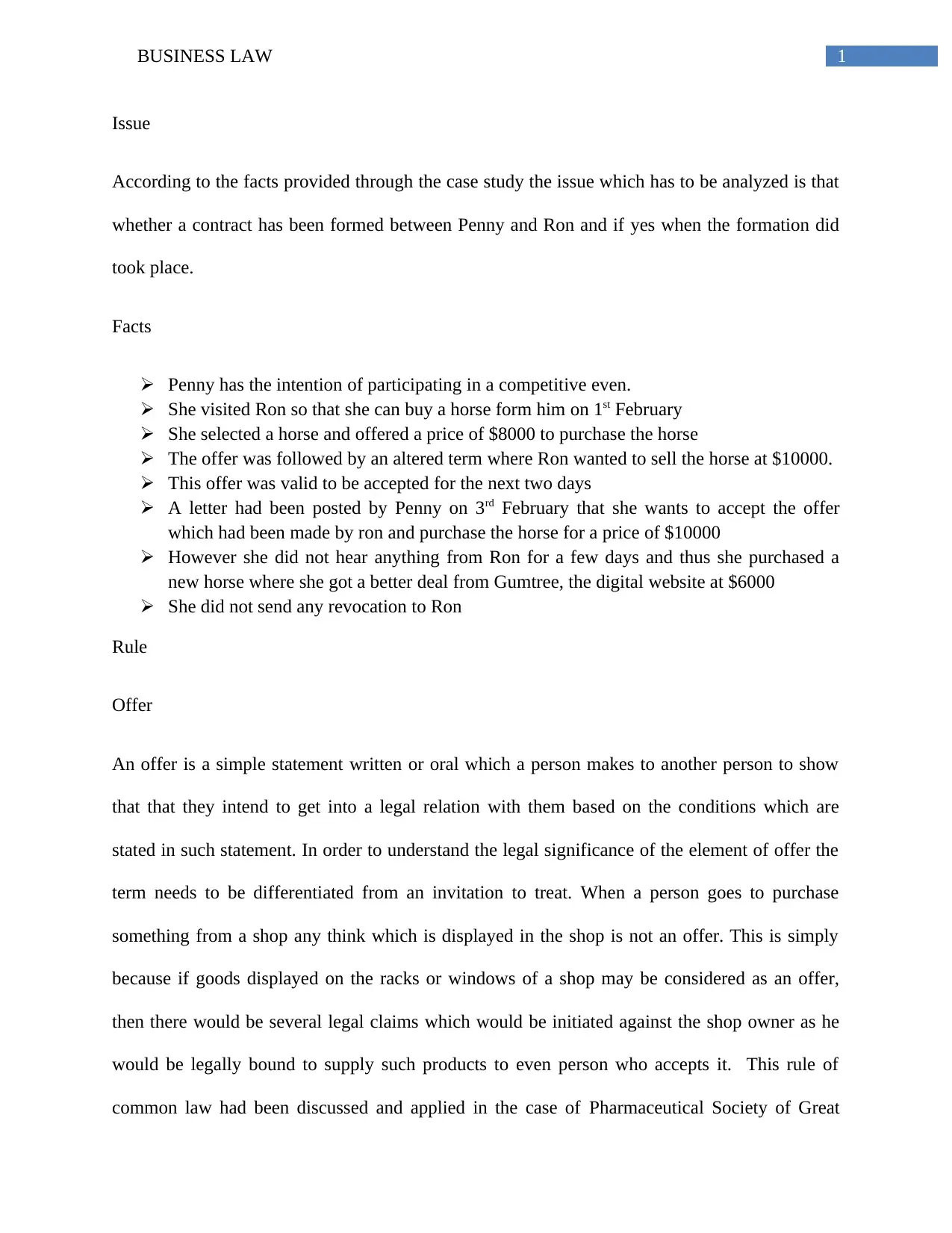
1BUSINESS LAW
Issue
According to the facts provided through the case study the issue which has to be analyzed is that
whether a contract has been formed between Penny and Ron and if yes when the formation did
took place.
Facts
Penny has the intention of participating in a competitive even.
She visited Ron so that she can buy a horse form him on 1st February
She selected a horse and offered a price of $8000 to purchase the horse
The offer was followed by an altered term where Ron wanted to sell the horse at $10000.
This offer was valid to be accepted for the next two days
A letter had been posted by Penny on 3rd February that she wants to accept the offer
which had been made by ron and purchase the horse for a price of $10000
However she did not hear anything from Ron for a few days and thus she purchased a
new horse where she got a better deal from Gumtree, the digital website at $6000
She did not send any revocation to Ron
Rule
Offer
An offer is a simple statement written or oral which a person makes to another person to show
that that they intend to get into a legal relation with them based on the conditions which are
stated in such statement. In order to understand the legal significance of the element of offer the
term needs to be differentiated from an invitation to treat. When a person goes to purchase
something from a shop any think which is displayed in the shop is not an offer. This is simply
because if goods displayed on the racks or windows of a shop may be considered as an offer,
then there would be several legal claims which would be initiated against the shop owner as he
would be legally bound to supply such products to even person who accepts it. This rule of
common law had been discussed and applied in the case of Pharmaceutical Society of Great
Issue
According to the facts provided through the case study the issue which has to be analyzed is that
whether a contract has been formed between Penny and Ron and if yes when the formation did
took place.
Facts
Penny has the intention of participating in a competitive even.
She visited Ron so that she can buy a horse form him on 1st February
She selected a horse and offered a price of $8000 to purchase the horse
The offer was followed by an altered term where Ron wanted to sell the horse at $10000.
This offer was valid to be accepted for the next two days
A letter had been posted by Penny on 3rd February that she wants to accept the offer
which had been made by ron and purchase the horse for a price of $10000
However she did not hear anything from Ron for a few days and thus she purchased a
new horse where she got a better deal from Gumtree, the digital website at $6000
She did not send any revocation to Ron
Rule
Offer
An offer is a simple statement written or oral which a person makes to another person to show
that that they intend to get into a legal relation with them based on the conditions which are
stated in such statement. In order to understand the legal significance of the element of offer the
term needs to be differentiated from an invitation to treat. When a person goes to purchase
something from a shop any think which is displayed in the shop is not an offer. This is simply
because if goods displayed on the racks or windows of a shop may be considered as an offer,
then there would be several legal claims which would be initiated against the shop owner as he
would be legally bound to supply such products to even person who accepts it. This rule of
common law had been discussed and applied in the case of Pharmaceutical Society of Great
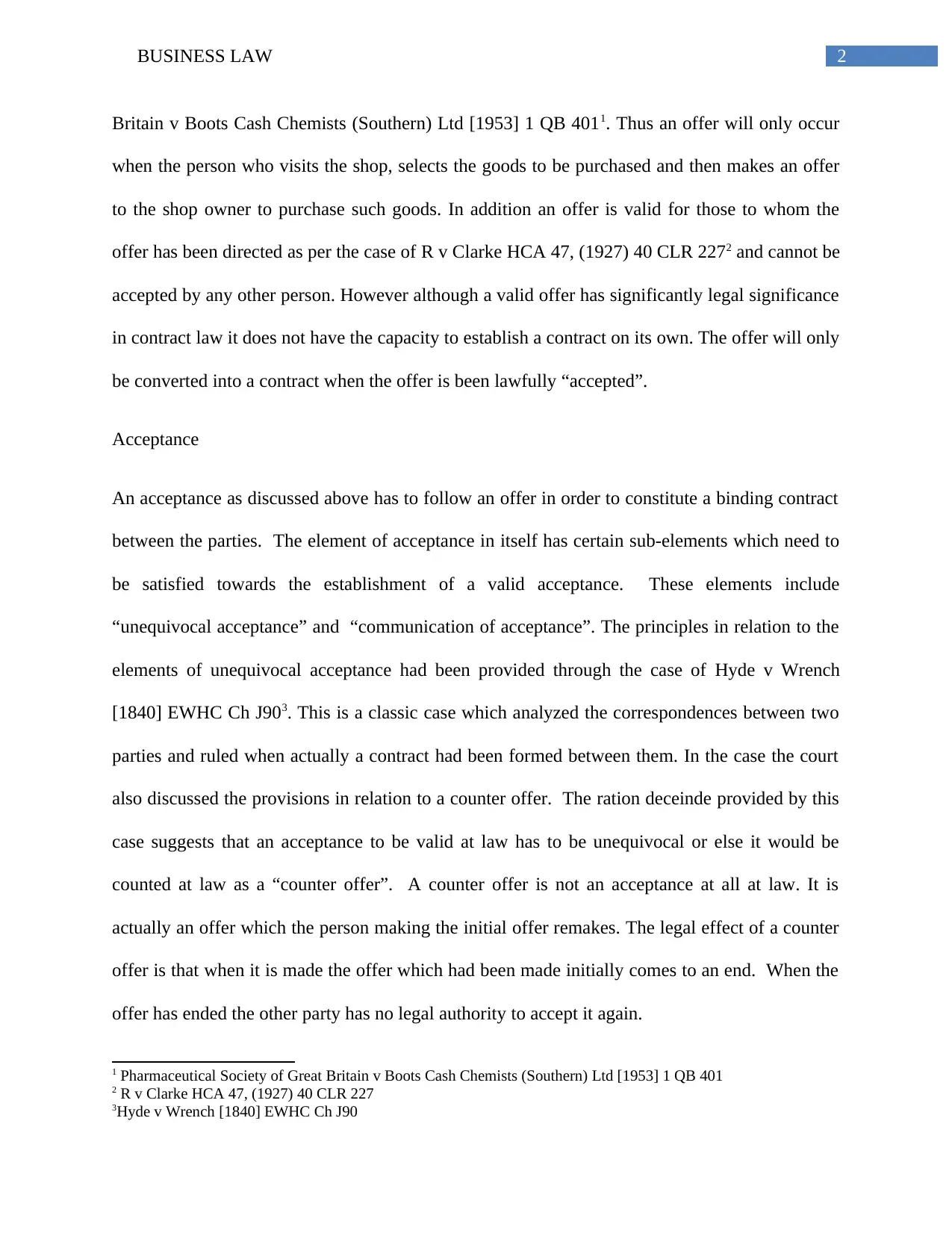
2BUSINESS LAW
Britain v Boots Cash Chemists (Southern) Ltd [1953] 1 QB 4011. Thus an offer will only occur
when the person who visits the shop, selects the goods to be purchased and then makes an offer
to the shop owner to purchase such goods. In addition an offer is valid for those to whom the
offer has been directed as per the case of R v Clarke HCA 47, (1927) 40 CLR 2272 and cannot be
accepted by any other person. However although a valid offer has significantly legal significance
in contract law it does not have the capacity to establish a contract on its own. The offer will only
be converted into a contract when the offer is been lawfully “accepted”.
Acceptance
An acceptance as discussed above has to follow an offer in order to constitute a binding contract
between the parties. The element of acceptance in itself has certain sub-elements which need to
be satisfied towards the establishment of a valid acceptance. These elements include
“unequivocal acceptance” and “communication of acceptance”. The principles in relation to the
elements of unequivocal acceptance had been provided through the case of Hyde v Wrench
[1840] EWHC Ch J903. This is a classic case which analyzed the correspondences between two
parties and ruled when actually a contract had been formed between them. In the case the court
also discussed the provisions in relation to a counter offer. The ration deceinde provided by this
case suggests that an acceptance to be valid at law has to be unequivocal or else it would be
counted at law as a “counter offer”. A counter offer is not an acceptance at all at law. It is
actually an offer which the person making the initial offer remakes. The legal effect of a counter
offer is that when it is made the offer which had been made initially comes to an end. When the
offer has ended the other party has no legal authority to accept it again.
1 Pharmaceutical Society of Great Britain v Boots Cash Chemists (Southern) Ltd [1953] 1 QB 401
2 R v Clarke HCA 47, (1927) 40 CLR 227
3Hyde v Wrench [1840] EWHC Ch J90
Britain v Boots Cash Chemists (Southern) Ltd [1953] 1 QB 4011. Thus an offer will only occur
when the person who visits the shop, selects the goods to be purchased and then makes an offer
to the shop owner to purchase such goods. In addition an offer is valid for those to whom the
offer has been directed as per the case of R v Clarke HCA 47, (1927) 40 CLR 2272 and cannot be
accepted by any other person. However although a valid offer has significantly legal significance
in contract law it does not have the capacity to establish a contract on its own. The offer will only
be converted into a contract when the offer is been lawfully “accepted”.
Acceptance
An acceptance as discussed above has to follow an offer in order to constitute a binding contract
between the parties. The element of acceptance in itself has certain sub-elements which need to
be satisfied towards the establishment of a valid acceptance. These elements include
“unequivocal acceptance” and “communication of acceptance”. The principles in relation to the
elements of unequivocal acceptance had been provided through the case of Hyde v Wrench
[1840] EWHC Ch J903. This is a classic case which analyzed the correspondences between two
parties and ruled when actually a contract had been formed between them. In the case the court
also discussed the provisions in relation to a counter offer. The ration deceinde provided by this
case suggests that an acceptance to be valid at law has to be unequivocal or else it would be
counted at law as a “counter offer”. A counter offer is not an acceptance at all at law. It is
actually an offer which the person making the initial offer remakes. The legal effect of a counter
offer is that when it is made the offer which had been made initially comes to an end. When the
offer has ended the other party has no legal authority to accept it again.
1 Pharmaceutical Society of Great Britain v Boots Cash Chemists (Southern) Ltd [1953] 1 QB 401
2 R v Clarke HCA 47, (1927) 40 CLR 227
3Hyde v Wrench [1840] EWHC Ch J90
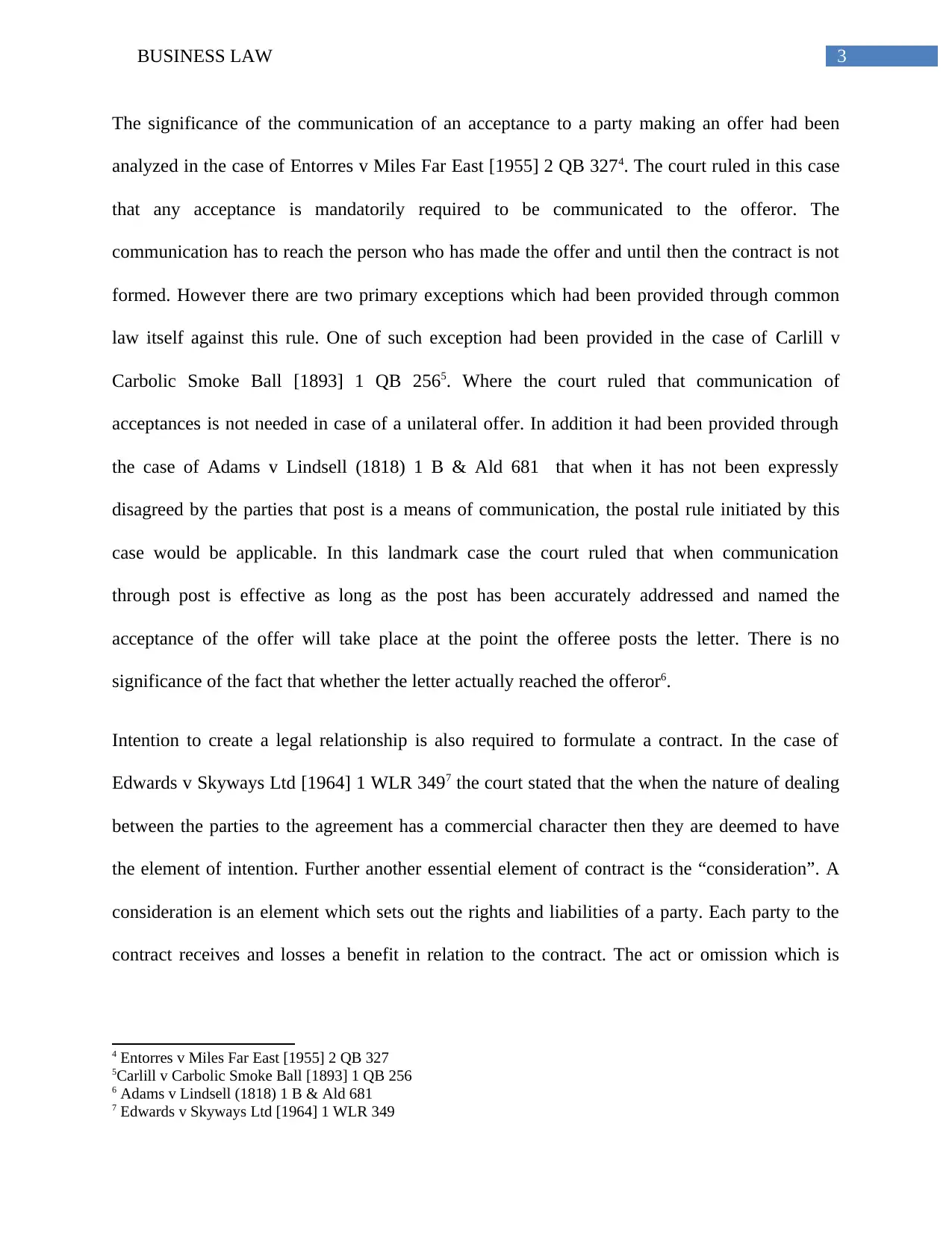
3BUSINESS LAW
The significance of the communication of an acceptance to a party making an offer had been
analyzed in the case of Entorres v Miles Far East [1955] 2 QB 3274. The court ruled in this case
that any acceptance is mandatorily required to be communicated to the offeror. The
communication has to reach the person who has made the offer and until then the contract is not
formed. However there are two primary exceptions which had been provided through common
law itself against this rule. One of such exception had been provided in the case of Carlill v
Carbolic Smoke Ball [1893] 1 QB 2565. Where the court ruled that communication of
acceptances is not needed in case of a unilateral offer. In addition it had been provided through
the case of Adams v Lindsell (1818) 1 B & Ald 681 that when it has not been expressly
disagreed by the parties that post is a means of communication, the postal rule initiated by this
case would be applicable. In this landmark case the court ruled that when communication
through post is effective as long as the post has been accurately addressed and named the
acceptance of the offer will take place at the point the offeree posts the letter. There is no
significance of the fact that whether the letter actually reached the offeror6.
Intention to create a legal relationship is also required to formulate a contract. In the case of
Edwards v Skyways Ltd [1964] 1 WLR 3497 the court stated that the when the nature of dealing
between the parties to the agreement has a commercial character then they are deemed to have
the element of intention. Further another essential element of contract is the “consideration”. A
consideration is an element which sets out the rights and liabilities of a party. Each party to the
contract receives and losses a benefit in relation to the contract. The act or omission which is
4 Entorres v Miles Far East [1955] 2 QB 327
5Carlill v Carbolic Smoke Ball [1893] 1 QB 256
6 Adams v Lindsell (1818) 1 B & Ald 681
7 Edwards v Skyways Ltd [1964] 1 WLR 349
The significance of the communication of an acceptance to a party making an offer had been
analyzed in the case of Entorres v Miles Far East [1955] 2 QB 3274. The court ruled in this case
that any acceptance is mandatorily required to be communicated to the offeror. The
communication has to reach the person who has made the offer and until then the contract is not
formed. However there are two primary exceptions which had been provided through common
law itself against this rule. One of such exception had been provided in the case of Carlill v
Carbolic Smoke Ball [1893] 1 QB 2565. Where the court ruled that communication of
acceptances is not needed in case of a unilateral offer. In addition it had been provided through
the case of Adams v Lindsell (1818) 1 B & Ald 681 that when it has not been expressly
disagreed by the parties that post is a means of communication, the postal rule initiated by this
case would be applicable. In this landmark case the court ruled that when communication
through post is effective as long as the post has been accurately addressed and named the
acceptance of the offer will take place at the point the offeree posts the letter. There is no
significance of the fact that whether the letter actually reached the offeror6.
Intention to create a legal relationship is also required to formulate a contract. In the case of
Edwards v Skyways Ltd [1964] 1 WLR 3497 the court stated that the when the nature of dealing
between the parties to the agreement has a commercial character then they are deemed to have
the element of intention. Further another essential element of contract is the “consideration”. A
consideration is an element which sets out the rights and liabilities of a party. Each party to the
contract receives and losses a benefit in relation to the contract. The act or omission which is
4 Entorres v Miles Far East [1955] 2 QB 327
5Carlill v Carbolic Smoke Ball [1893] 1 QB 256
6 Adams v Lindsell (1818) 1 B & Ald 681
7 Edwards v Skyways Ltd [1964] 1 WLR 349
Secure Best Marks with AI Grader
Need help grading? Try our AI Grader for instant feedback on your assignments.
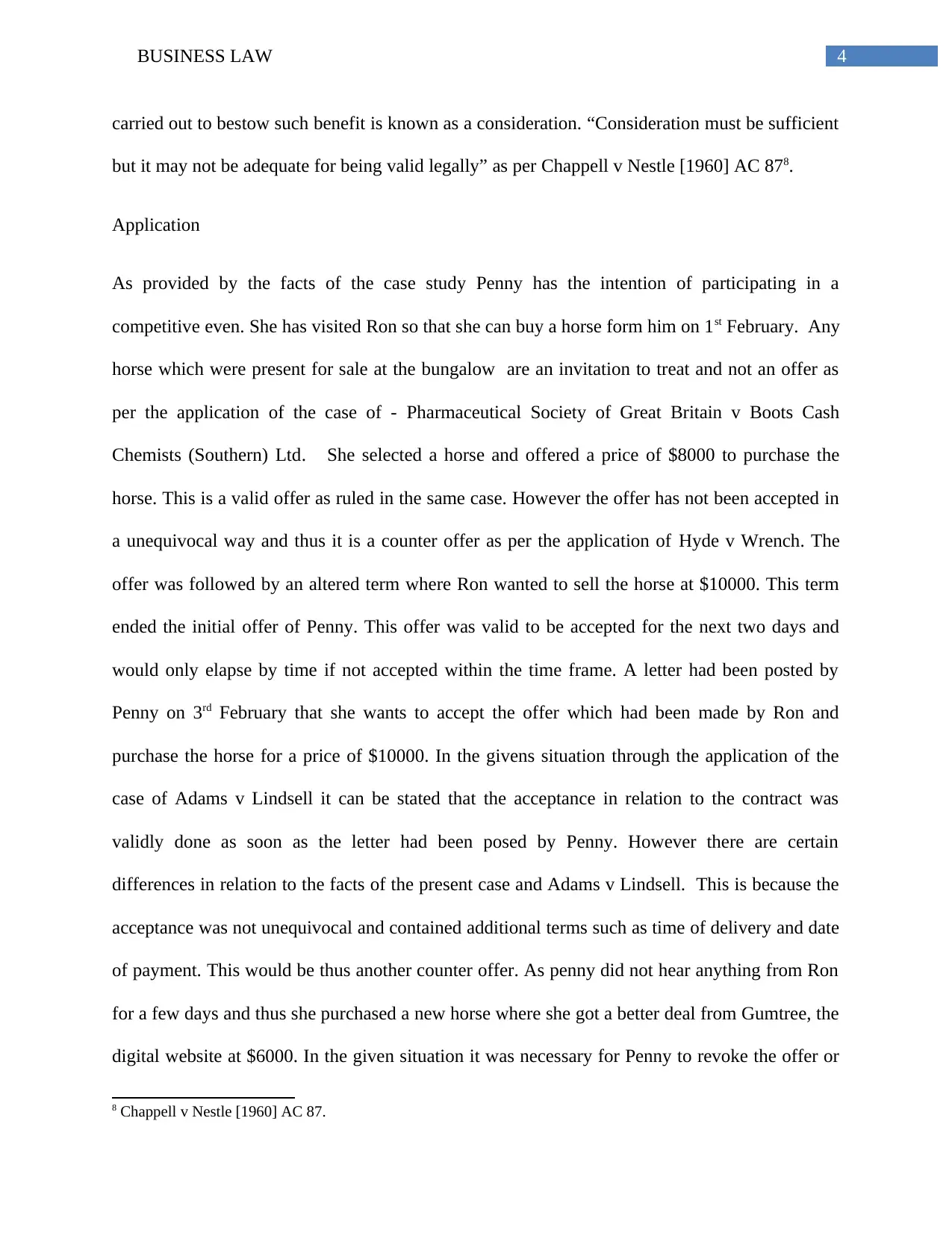
4BUSINESS LAW
carried out to bestow such benefit is known as a consideration. “Consideration must be sufficient
but it may not be adequate for being valid legally” as per Chappell v Nestle [1960] AC 878.
Application
As provided by the facts of the case study Penny has the intention of participating in a
competitive even. She has visited Ron so that she can buy a horse form him on 1st February. Any
horse which were present for sale at the bungalow are an invitation to treat and not an offer as
per the application of the case of - Pharmaceutical Society of Great Britain v Boots Cash
Chemists (Southern) Ltd. She selected a horse and offered a price of $8000 to purchase the
horse. This is a valid offer as ruled in the same case. However the offer has not been accepted in
a unequivocal way and thus it is a counter offer as per the application of Hyde v Wrench. The
offer was followed by an altered term where Ron wanted to sell the horse at $10000. This term
ended the initial offer of Penny. This offer was valid to be accepted for the next two days and
would only elapse by time if not accepted within the time frame. A letter had been posted by
Penny on 3rd February that she wants to accept the offer which had been made by Ron and
purchase the horse for a price of $10000. In the givens situation through the application of the
case of Adams v Lindsell it can be stated that the acceptance in relation to the contract was
validly done as soon as the letter had been posed by Penny. However there are certain
differences in relation to the facts of the present case and Adams v Lindsell. This is because the
acceptance was not unequivocal and contained additional terms such as time of delivery and date
of payment. This would be thus another counter offer. As penny did not hear anything from Ron
for a few days and thus she purchased a new horse where she got a better deal from Gumtree, the
digital website at $6000. In the given situation it was necessary for Penny to revoke the offer or
8 Chappell v Nestle [1960] AC 87.
carried out to bestow such benefit is known as a consideration. “Consideration must be sufficient
but it may not be adequate for being valid legally” as per Chappell v Nestle [1960] AC 878.
Application
As provided by the facts of the case study Penny has the intention of participating in a
competitive even. She has visited Ron so that she can buy a horse form him on 1st February. Any
horse which were present for sale at the bungalow are an invitation to treat and not an offer as
per the application of the case of - Pharmaceutical Society of Great Britain v Boots Cash
Chemists (Southern) Ltd. She selected a horse and offered a price of $8000 to purchase the
horse. This is a valid offer as ruled in the same case. However the offer has not been accepted in
a unequivocal way and thus it is a counter offer as per the application of Hyde v Wrench. The
offer was followed by an altered term where Ron wanted to sell the horse at $10000. This term
ended the initial offer of Penny. This offer was valid to be accepted for the next two days and
would only elapse by time if not accepted within the time frame. A letter had been posted by
Penny on 3rd February that she wants to accept the offer which had been made by Ron and
purchase the horse for a price of $10000. In the givens situation through the application of the
case of Adams v Lindsell it can be stated that the acceptance in relation to the contract was
validly done as soon as the letter had been posed by Penny. However there are certain
differences in relation to the facts of the present case and Adams v Lindsell. This is because the
acceptance was not unequivocal and contained additional terms such as time of delivery and date
of payment. This would be thus another counter offer. As penny did not hear anything from Ron
for a few days and thus she purchased a new horse where she got a better deal from Gumtree, the
digital website at $6000. In the given situation it was necessary for Penny to revoke the offer or
8 Chappell v Nestle [1960] AC 87.
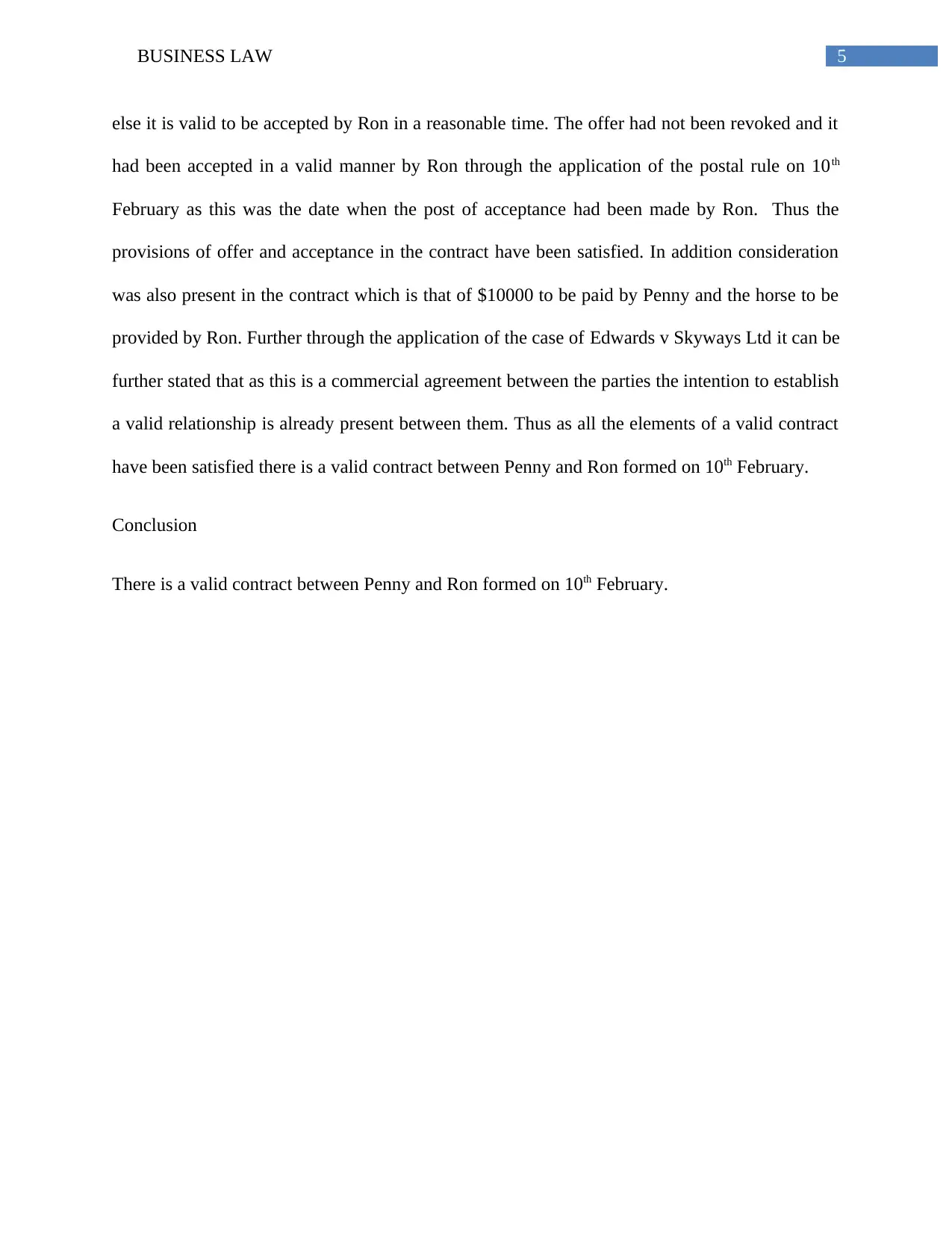
5BUSINESS LAW
else it is valid to be accepted by Ron in a reasonable time. The offer had not been revoked and it
had been accepted in a valid manner by Ron through the application of the postal rule on 10th
February as this was the date when the post of acceptance had been made by Ron. Thus the
provisions of offer and acceptance in the contract have been satisfied. In addition consideration
was also present in the contract which is that of $10000 to be paid by Penny and the horse to be
provided by Ron. Further through the application of the case of Edwards v Skyways Ltd it can be
further stated that as this is a commercial agreement between the parties the intention to establish
a valid relationship is already present between them. Thus as all the elements of a valid contract
have been satisfied there is a valid contract between Penny and Ron formed on 10th February.
Conclusion
There is a valid contract between Penny and Ron formed on 10th February.
else it is valid to be accepted by Ron in a reasonable time. The offer had not been revoked and it
had been accepted in a valid manner by Ron through the application of the postal rule on 10th
February as this was the date when the post of acceptance had been made by Ron. Thus the
provisions of offer and acceptance in the contract have been satisfied. In addition consideration
was also present in the contract which is that of $10000 to be paid by Penny and the horse to be
provided by Ron. Further through the application of the case of Edwards v Skyways Ltd it can be
further stated that as this is a commercial agreement between the parties the intention to establish
a valid relationship is already present between them. Thus as all the elements of a valid contract
have been satisfied there is a valid contract between Penny and Ron formed on 10th February.
Conclusion
There is a valid contract between Penny and Ron formed on 10th February.
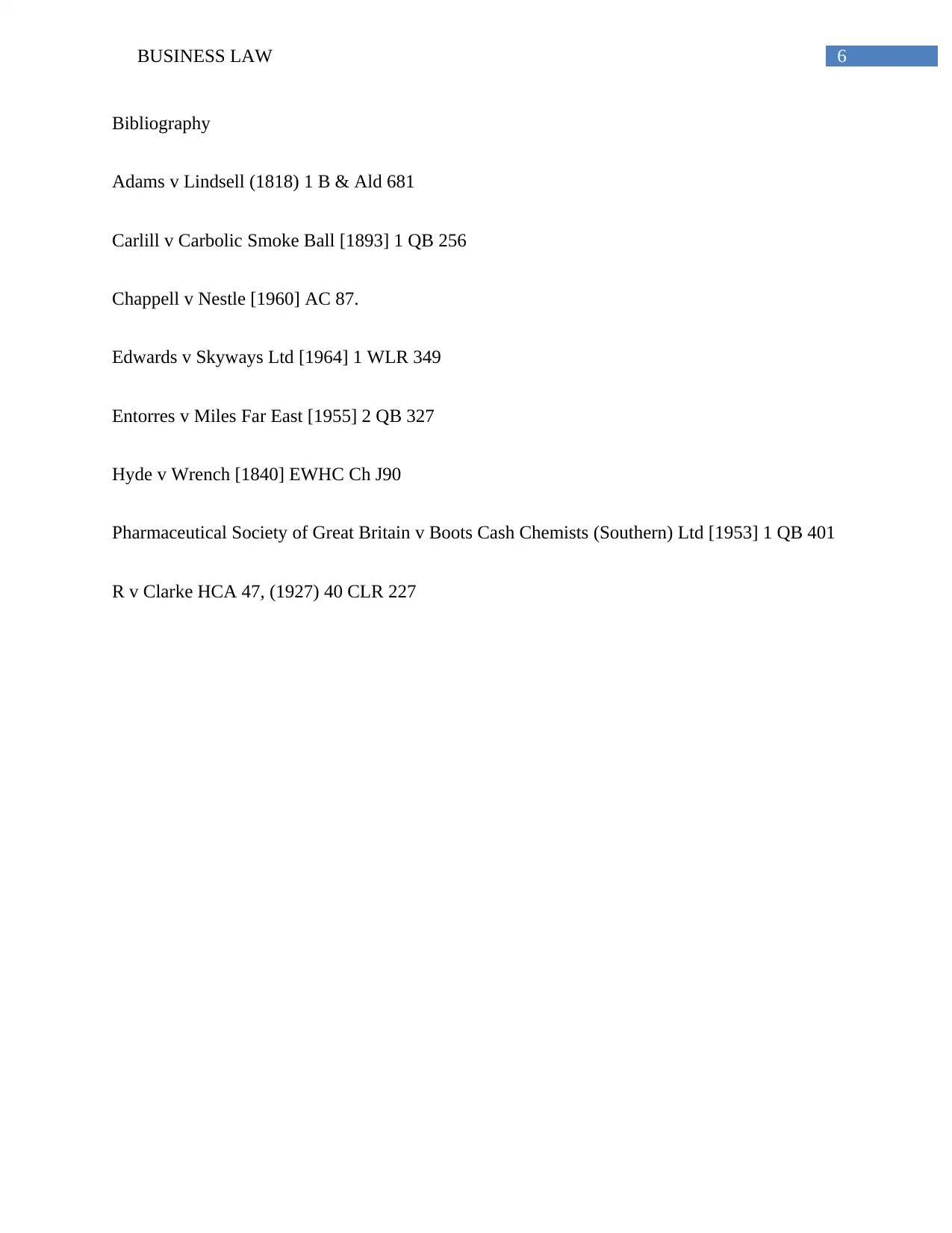
6BUSINESS LAW
Bibliography
Adams v Lindsell (1818) 1 B & Ald 681
Carlill v Carbolic Smoke Ball [1893] 1 QB 256
Chappell v Nestle [1960] AC 87.
Edwards v Skyways Ltd [1964] 1 WLR 349
Entorres v Miles Far East [1955] 2 QB 327
Hyde v Wrench [1840] EWHC Ch J90
Pharmaceutical Society of Great Britain v Boots Cash Chemists (Southern) Ltd [1953] 1 QB 401
R v Clarke HCA 47, (1927) 40 CLR 227
Bibliography
Adams v Lindsell (1818) 1 B & Ald 681
Carlill v Carbolic Smoke Ball [1893] 1 QB 256
Chappell v Nestle [1960] AC 87.
Edwards v Skyways Ltd [1964] 1 WLR 349
Entorres v Miles Far East [1955] 2 QB 327
Hyde v Wrench [1840] EWHC Ch J90
Pharmaceutical Society of Great Britain v Boots Cash Chemists (Southern) Ltd [1953] 1 QB 401
R v Clarke HCA 47, (1927) 40 CLR 227
1 out of 7
Related Documents
Your All-in-One AI-Powered Toolkit for Academic Success.
+13062052269
info@desklib.com
Available 24*7 on WhatsApp / Email
![[object Object]](/_next/static/media/star-bottom.7253800d.svg)
Unlock your academic potential
© 2024 | Zucol Services PVT LTD | All rights reserved.



